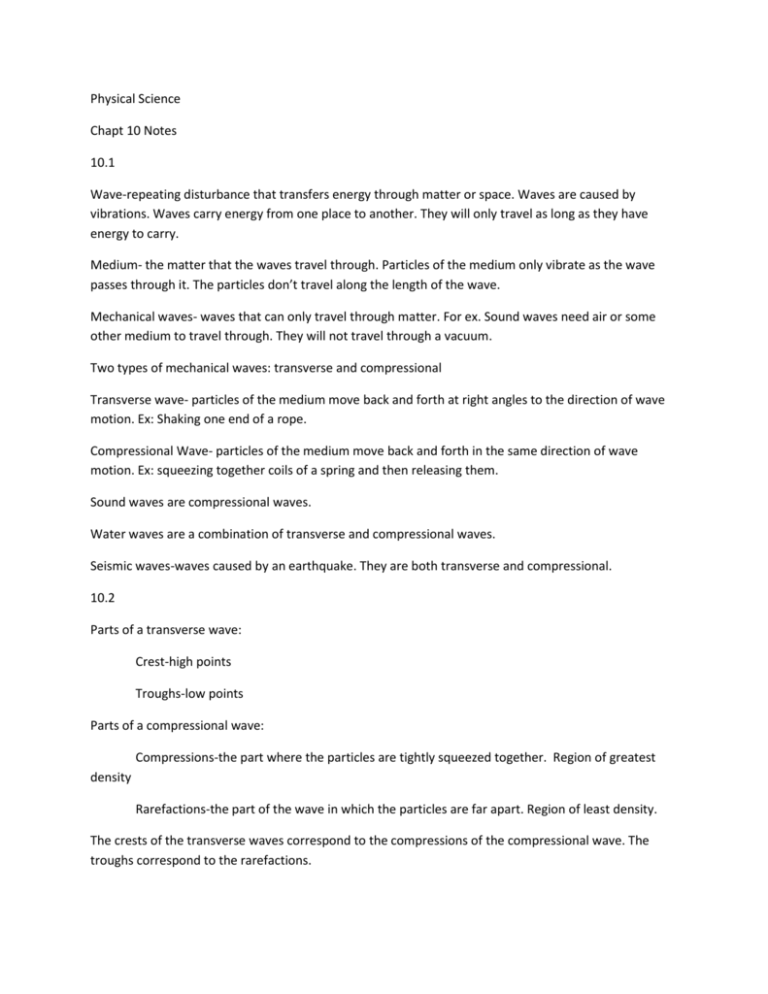Physical Science Chpt 10
advertisement

Physical Science Chapt 10 Notes 10.1 Wave-repeating disturbance that transfers energy through matter or space. Waves are caused by vibrations. Waves carry energy from one place to another. They will only travel as long as they have energy to carry. Medium- the matter that the waves travel through. Particles of the medium only vibrate as the wave passes through it. The particles don’t travel along the length of the wave. Mechanical waves- waves that can only travel through matter. For ex. Sound waves need air or some other medium to travel through. They will not travel through a vacuum. Two types of mechanical waves: transverse and compressional Transverse wave- particles of the medium move back and forth at right angles to the direction of wave motion. Ex: Shaking one end of a rope. Compressional Wave- particles of the medium move back and forth in the same direction of wave motion. Ex: squeezing together coils of a spring and then releasing them. Sound waves are compressional waves. Water waves are a combination of transverse and compressional waves. Seismic waves-waves caused by an earthquake. They are both transverse and compressional. 10.2 Parts of a transverse wave: Crest-high points Troughs-low points Parts of a compressional wave: Compressions-the part where the particles are tightly squeezed together. Region of greatest density Rarefactions-the part of the wave in which the particles are far apart. Region of least density. The crests of the transverse waves correspond to the compressions of the compressional wave. The troughs correspond to the rarefactions. Frequency-number of wavelengths that pass a fixed point each second. The SI unit for frequency is the Hertz. The frequency of the vibration that is creating the wave equals the frequency of the wave. Wavelength- the distance from the crest of one wave to the crest of the next. Or from any part on the first wave to the corresponding part on the next wave. As frequency increases, wavelength decreases, or if frequency decreases, wavelength increases. For example, if frequency doubles, wavelength is halved. Period- the amount of time it takes for one wavelength to pass a point. Wave speed depends on the medium it is travelling through. Speed = frequency X wavelength. Amplitude- related to the energy a wave carries. The greater the amount of energy, the greater the amplitude of the wave. Amplitude of a transverse wave- distance from the rest position to the crest or trough Amplitude of a compressional wave- the more dense the compressions and less dense the rarefactions, the greater the energy. 10.3 Reflection occurs when a wave strikes an object and bounces back off of it. The property of reflection is what allows you to see yourself in a mirror. You see this paper, or anything else that doesn’t give off its own light, because light is reflected off of it into your eyes. Echo- reflection of a sound wave. Law of Reflection- the angle of incidence is equal to the angle of refection. The angle of incidence is the angle of the incoming wave. The angle of reflection is the angle of the reflected wave. These angles are formed by the wave and the normal. Normal- an imaginary line drawn perpendicular to the reflecting surface. Refraction- the bending of a wave caused by a change in its speed as it moves from one medium to another. The greater the change in speed, the greater the bending of the wave. When light passes from a less dense medium to a more dense medium, it slows down and bends toward the normal. If it passes from a more dense medium to a less dense medium, it speeds up and is bent away from the normal (the imaginary line drawn perpendicular to the surface between the two mediums at the point where the wave enters the new medium. In order for light to refract when it goes from one medium to another, it must hit the border between the mediums at an angle. Diffraction- occurs when an object causes a wave to change direction and bend around it. It may diffract around an obstacle or in passing through an opening. Although refraction and diffraction both involve the bending of a wave, refraction occurs when a wave passes through an object, and diffraction occurs when a wave passes around an object. Diffraction is the reason that you can hear around corners. The more similar in wavelength of a wave is to the size of the opening the wave is passing through or the obstacle it is going around, the more diffraction that occurs. AM radio waves have longer wavelengths than FM radio wave. Therefore, they diffract more around large objects such as buildings and mountain. Therefore, AM radio reception is better than FM around tall buildings and hills. Interference- occurs when two or more waves overlap to form a new wave. Constructive interference- The waves add together to make a new wave with an amplitude that is equal to the sum of the amplitudes of the interfering waves. The occurs when the crests of the waves overlap, or when the compressions of compressional waves overlap. Destructive interference- The waves subtract from each other to make an new wave of lesser amplitude. This occurs when the crest of one overlaps with the trough of the other, or rarefactions of one overlaps with compressions of the other. Resonance- the process by which an object is made to vibrate by absorbing energy at its natural frequencies.







